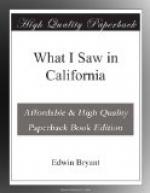In the afternoon I walked to the summit of one of the elevated hills in the vicinity of the town, from which I had a view of the entrance to the bay of San Francisco and of the Pacific Ocean. A thick fog hung over the ocean outside of the bay. The deep roar of the eternally restless waves, as they broke one after another upon the beach, or dashed against the rock-bound shore, could be heard with great distinctness, although some five or six miles distant. The entrance from the ocean into the bay is about a mile and half in breadth. The waters of the bay appear to have forced a passage through the elevated ridge of hills next to the shore of the Pacific. These rise abruptly on either side of the entrance. The water at the entrance and inside is of sufficient depth to admit the largest ship that was ever constructed; and so completely land-locked and protected from the winds is the harbour, that vessels can ride at anchor in perfect safety in all kinds of weather. The capacity of the harbour is sufficient for the accommodation of all the navies of the world.
The town of San Francisco is situated on the south side of the entrance, fronting on the bay, and about six miles from the ocean. The flow and ebb of the tide are sufficient to bring a vessel to the anchorage in front of the town and carry it outside, without the aid of wind, or even against an unfavourable wind. A more approachable harbour, or one of greater security, is unknown to navigators. The permanent population of the town is at this time between one and two hundred,[1] and is composed almost exclusively of foreigners. There are but two or three native Californian families in the place. The transient population, and at present it is quite numerous, consists of the garrison of marines stationed here, and the officers and crews attached to the merchant and whale ships lying in the harbour. The houses, with a few exceptions, are small adobes and frames, constructed without regard to architectural taste, convenience, or comfort. Very few of them have either chimneys or fire-places. The inhabitants contrive to live the year round without fires, except for cooking. The position of San Francisco for commerce is, without doubt, superior to any other port on the Pacific coast of North America. The country contiguous and contributory to it cannot be surpassed in fertility, healthfulness of climate, and beauty of scenery. It is capable of producing whatever is necessary to the sustenance of man, and many of the luxuries of tropical climates, not taking into the account the mineral wealth of the surrounding hills and mountains, which there is reason to believe is very great. This place is, doubtless, destined to become one of the largest and most opulent commercial cities in the world, and under American authority it will rise with astonishing rapidity. The principal merchants now established here are Messrs. Leidesdorff, Grimes and Davis, and Frank Ward, a young gentleman recently from New York. These houses carry on an extensive and profitable commerce with the interior, the Sandwich Islands, Oregon, and the southern coast of the Pacific. The produce of Oregon for exportation is flour, lumber, salmon, and cheese; of the Sandwich Islands, sugar, coffee, and preserved tropical fruits.




